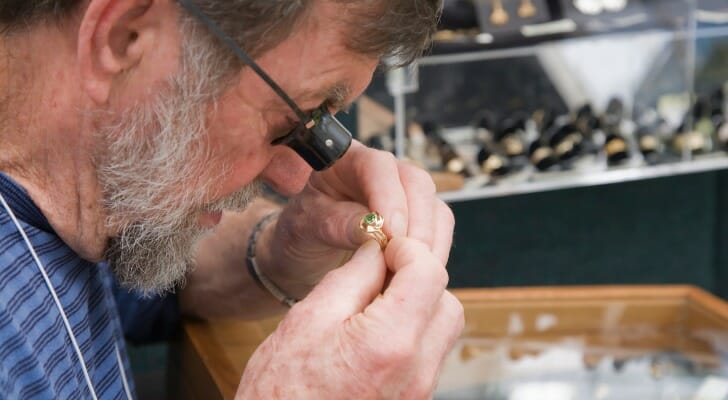It might seem easier to find a partner and plan a proposal than it is to buy the perfect engagement ring. In addition to being expensive, rings are seen as a symbol of love for your significant other and an agreement to be together forever. Friends and family will all want to know what it looks like as soon as the proposal is over. That’s a lot of pressure on the purchase, which most people only make once in their life. Follow our six-step process to find and purchase an engagement ring that’s right for you, your partner, and your future. Consider working with a financial advisor for expert guidance on how to handle personal financial issues.
Determine your budget.
Antiquated societal rules encourage marriage hopefuls to spend either two or three month’s salary on an engagement ring. According to wedding planning website The Knot’s latest Real Weddings Study, Americans spent an average of $5,764 on engagement rings in 2017.
Neither of these “standards” should determine your budget, though.
In reality, each person should decide how much to spend on an engagement ring based on his or her current financial situation and goals for the future. It’s best to calculate a range before you start shopping. And as with every budget, it’s just as important to stick with it than it is to set it. After all, having the funds for an epic honeymoon and wonderful life together is much more romantic than going into debt after splurging on a ring.
Keeping that in mind, we’d strongly advise against borrowing money to pay for a ring. Using a credit card is fine so long as you’re intending to pay off the bill immediately. (Indeed, using a credit card is advisable, as many credit cards offer purchase protection that could come in handy in the event that it’s lost or stolen shortly after purchase.) Even tapping a bit of your savings is fine, though we’d advise against raiding your retirement accounts.
The bottom line: Only spend what you can feasibly afford. Remember, you can always upgrade certain elements of the ring down the line.
Learn the basics.
It’s always good to understand a commodity before you invest in it. For diamonds, that means studying the four Cs: cut, color, carat, and clarity. The cut of a diamond defines how much it sparkles in the light. It is measured by grade from excellent to poor. Carat refers to the weight of the diamond. Each carat is .20 grams. The number of flaws, flecks, lines, and other imperfections determine a ring’s clarity. Rings are judged on a clarity scale from flawless to included. Lastly, the color of a diamond falls somewhere between “D” (no color) to “Z,” which looks faded yellow.
The unofficial fifth C is certification. Only buy a diamond if it comes with a report from the Gemological Institute of America (GIA) or a similar agency that verifies what the seller claims.
On top of these Cs, you’ll also want to consider the diamond shape and ring setting. Round stones are very popular, but you can also select from pear, oval, emerald, princess, and imperfect shapes. Settings can be gold, rose gold, white gold, platinum, silver or a mix of these metals.
While it’s best to fall on the higher end of each scale, most experts consider cut to be the most important of the four Cs. Meanwhile, some consumers value carat above all else. Compromising on color and clarity often allow buyers to get a larger, more brilliant stone for less. Purchasing just shy of a carat or half-carat mark is another smart cost-cutting strategy.
Research your beloved’s style.

Of course, the best engagement ring will reflect your partner’s taste. To really wow him or her at the proposal, you’ll have to do some covert investigating. First and foremost, observe their other jewelry. When you pass a store, take note of what styles, shapes, and sizes catch his or her eye. Look and listen for their reaction to other people’s rings. Maybe he or she has a Pinterest board you can reference. Friends and family members can also be a great resource into your future fiancée’s ring preferences.
There’s no rulebook that says you have to keep the ring a surprise. If you think he or she would prefer it, involve them in the process directly. Let them try a few on and tackle design decisions together. They may have a very specific idea in mind that you haven’t heard about before.
Don’t discount other stones, either. We gave a breakdown of diamond buying because diamonds are typically included in an engagement ring; but opals, amethysts, rubies, emeralds, sapphires, garnets, and sunstones can be just as special. Maybe there is even an antique or family heirloom to include. And if your partner is socially conscious, consider a conflict-free gem from a confirmed ethical vendor.
Find a good seller.

Speaking of vendors, there are a wide range of options when it comes to engagement rings. You could visit a retailer, search online, or go to a jeweler. No matter what you ultimately decide, it’s a good idea to shop around and compare the prices of several ring options that fit your partner’s preferences. Big-name chains like Tiffany, Zales, and Cartier can be much more expensive without offering any improvement in quality.
Since diamond prices are unregulated, it’s best to follow a reputable recommendation if you chose to work with a private jeweler. The GIA, Jewelers of America, and Better Business Bureau websites should also offer some helpful information when it comes to finding a good seller.
If you’re worried about affording the ring, you could also look for a seller that offers financing. Just make sure the interest rate isn’t too outrageous. You should also look into return policies in case your partner doesn’t love it. It’s hard to believe, but some ring makers have a strict no-returns policy.
Protect your investment.
Once you’ve spent all this time and money on designing and buying the perfect engagement ring, it’s time to ensure this sentimental purchase is properly protected. Your partner will likely wear this everyday, leaving it vulnerable to loss, damage, and theft. The Knot reports that it costs $1 to $2 to insure your ring each year for every $100 it would cost to replace.
Some vendors offer an insurance policy themselves. If not, you can add the ring to your homeowners or renters insurance. You can also purchase a policy specifically for the ring. An actual value or market value policy will be cheaper than a replacement policy, but it won’t cover depreciation. No matter what you choose, be sure to read the fine print so you don’t have any uncomfortable surprises later.
To secure insurance on the engagement ring, you will need the ring’s official documentation as well as a receipt or other proof of purchase. Depending on the value of the ring and the coverage you’re looking for, you may also have to get the ring officially appraised.
Start early.
Keep in mind that it could take a while for your engagement ring to be ready. Typically, large retailers need at least six weeks to finalize the style and setting along with any customizations you request. For wholesalers and jewelers, it could be even longer. Be sure you factor this wait time when you make your plan. Once you’ve got the perfect ring for your partner, all that’s left to do is propose.
Building a (Financial) Life Together
- Spending thousands on an engagement ring might seem like a big commitment. But it’s nothing compared to the commitment of commingling your finances with another person. Consider getting on the same page about money with your future spouse. And while it’s not exactly romantic, consider getting a prenuptial agreement.
- Another big step to take with your life partner? Putting together a financial plan. Talk about your long-term financial and retirement goals with a financial advisor. If you don’t have a financial advisor yet, finding one doesn’t have to be hard. SmartAsset’s free tool matches you with up to three vetted financial advisors who serve your area, and you can interview your advisor matches at no cost to decide which one is right for you. If you’re ready to find an advisor who can help you achieve your financial goals, get started now.
Photo Credit: © iStock/Jacob Wackerhausen, © iStock/Rawpixel, © iStock/KingWu
